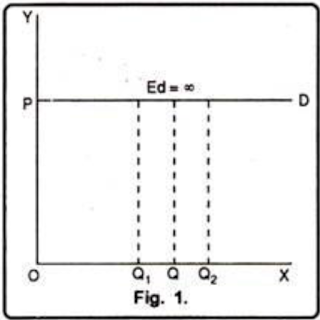- Get link
- X
- Other Apps
- Get link
- X
- Other Apps
VIDEO LINK
UNIT 03
Business Economics
PART 04
=======================
MCQ: Which of the following statements are correct?
a. Price Elasticity of Demand = % Change in Quantity Demanded / % Change in Price.
b. It is not necessary that the change in demand is always proportional to change in price
c. Income elasticity of demand refers to the change in quantity demanded of a product as a result of a change in consumer’s income
d. All of the above
Price Elasticity of Demand
- Price is an important determinant of demand of a product
- Price Elasticity of Demand refers to the extent of change in demand as a result of change in price of the product
- Dr. Marshall has pro-founded the concept of price elasticity of demand.
- the price elasticity of demand ranges from zero to infinity.
- It can be equal to zero, less than one, greater than one and equal to unity.
Degrees of price elasticity of demand
1. Perfectly Elastic Demand (Infinite elasticity)
Perfectly elastic demand is said to happen when a little change in price leads to an infinite change in quantity demanded.
Elasticity of demand = infinite
In such a case the shape of the demand curve will be horizontal straight line parallel to x axis
2. Perfectly Inelastic Demand:
Demand is unaffected by change in price
The elasticity of demand in this case will be equal to zero (ed = 0).
The elasticity of demand in this case will be equal to zero (ed = 0).
Demand curve will be vertical straight line parallel to y axis
3. Unitary Elastic Demand:
Given proportionate change in the price level brings about an equal proportionate change in quantity demanded.
Elastic demand is exactly one
Marshall calls it unit elastic.
Shape of Unitary Elastic Demand curve will be a rectangular hyperbola
Relatively Elastic Demand:
Small change in price leads to a big change in quantity demanded.
Elasticity of demand is said to be more than one (ed > 1)
DD curve has a flattened slope
Relatively Inelastic Demand:
A given percentage changes in price produces a relatively less percentage change in quantity demanded.
Elasticity of demand is said to be less than one (ed < 1)
DD cure has steep downward slope
Measurement of price elasticity of demand
Change in quantity/original quantity * change in price / original price
Income Elasticity of Demand
Income elasticity of demand measures the responsiveness of demand for a particular good to changes in consumer income
Income Elasticity of Demand = % Change in Quantity Demanded / % Change in income
Measurement of income elasticity of demand
Change in quantity/original quantity * change in income / original income
Types of Income Elasticity
Positive Income Elasticity of Demand:
When the demand for a product increases with increase in consumer’s income and decreases with decrease in consumer’s income
The income elasticity of demand is positive for normal goods and superior goods
Dd cure will slop upward from left to right
Negative Income Elasticity of Demand:
Demand for a product decreases with increase in consumer’s income.
The income elasticity of demand is negative for inferior goods
DD Curve slope downward from left to right
Zero Income Elasticity of Demand
No effect of increase in consumer’s income on the demand of product.
The income elasticity of demand is zero (ey = 0) in case of essential goods
DD curve is vertical straight line perpendicular to x axis
Advertisement elasticity of demand
Measures the responsiveness of a good's demand to changes in spending on advertising
Cross elasticity of demand
Measures the responsiveness in the quantity demanded of one good when the price for another good changes
The cross elasticity of demand for substitute goods is always positive
The cross elasticity of demand for complementary goods is negative.
==========================
- Get link
- X
- Other Apps










Comments
Post a Comment